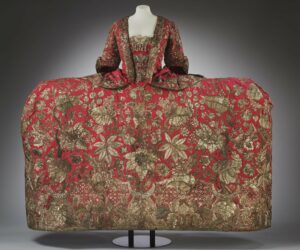
Marie Antoinette and Her Squad
1 – ⚜️🎀It's time for #ThreadTalk & today we're going big with the infamous Marie Antoinette: the oft-misquoted, scandalous, fashion forward last Queen of France (before the Revolution).
Her image is iconic, but she did not do it alone. To her dying day, she had a *squad*.🎀⚜️

2 – Born in 1755, Marie was not French; she was Austrian. Daughter of Empress Maria Theresa, Hapsburgs bigwig.
Known then as Maria Antonia, she even met young Wolfgang Amadeus Mozart during her charmed childhood.
Here she is in 1762, bedecked in satin, ribbons, and flowers.

3 – At 14, she was married by proxy to the Dauphin of France, in an effort to secure peace between their regions.
It was not a marriage of passion & the French people were not thrilled with an Austrian future monarch. But, she had one thing going: she was *fashionable*.

4 – Scandals followed her like precocious puppies. Marie's wedding dress caused a stir. Why?
It was terribly ill-fitting 😲. Also encrusted in diamonds. Though the dress no longer exists, the fit caused shockwaves throughout the country. To say nothing of the flaunted expense.

5 – We have Rose Bertin to thank for curating Marie's post-wedding image.
Rose was born in humble circumstances, in Picardie, but she received a basic education. At 16, she moved to Paris to apprentice as a milliner.
The new queen was *obsessed* with Rose's designs.

6 – Together, Marie and Rose concocted the over-the-top styles of the age, including hair poufs measuring over 3' & elaborate feather decorations called panache.🪶
This dimpled wig in this portrait is one of my favorites. Who needs panache when your dress is gilded sea foam?

7 – But we can't give Rose all the credit for hair.
Another member of the squad was Léonard Autié. The son of household servants, after moving to Paris like Rose, he met the actress Julie Niébert and began getting notice for his flamboyant hair designs.
Marie noticed.

8 – Caricature artists mocked the towering wigs in papers, and Marie's frivolous spending (and gambling) along with it.
One of the most infamous hair styles was known as À La Belle Poule, commemorating a naval victory over the English with a *replica* of the actual ship.⛵️

9 – By 1778, the tide of trends (haha) rose so high we saw the invent of the first fashion plates from Galerie des Modes et Costumes Français.
These sets of prints, sold in groups of six, served to show Parisians real-life applications of the hottest fashion, in vivid color!

10 – Another 1778 ensemble here really goes to great heights, even though one of those feathers looks like a tongue.
This kind of marketing really got the upper crust into fashion action, stoking competition. The sheer amount of fabric $$$ here is beyond cost calculation.

11 – What does a monarch do when everyone has glommed on to the most ostentatious fashion?
She pivots, of course.
But first, we must meet Élisabeth Vigée Le Brun. Trained initially by her father, she became a prolific & celebrated portraitist of the Rococo.
(I have a crush.)

12 – Vigée Le Brun painted over 660 portraits in her lifetime, and was admitted to the Académie royale de peinture et de sculpture: 1 of 14 women (of 550 total members) in its history pre-Revolution.
She also caused a scandal with this portrait for her open mouth! Truly! 👄

13 – As Marie like to collect famous people, Vigée Le Brun became her official portrait painter & gambled her own career on their next move.
In 1783, Vigée Le Brun painted Marie in a simple muslin chemise, known as a robe de gaulle, and put it on display in public. 😲😲😲

14 – To our modern eyes, this may just look a bit frothy & romantic.
Then, it was shocking. That the Queen would wear pastoral peasant clothes, let alone such revealing attire! And in fabric associated with Britain and India!
COTTON & NOT SILK!
Below: another Le Brun.

15 – The gallery insisted the portrait be removed from public view and…
Of course the rich folk became obsessed with it. Suddenly, cotton became all the rage, fueling the slave trade to the Americas and the devastation of the industry in India. We know that story.

16 – As exhibited by the Regency period, plain, white, diaphanous gowns became all the rage. Not just in England, but across the world.
Sure enough, the silk industry in France tanked over the next two decades, and well…
The French people had had enough, to say the least.

17 – The people rose up. They could not take one day more.
And by 1792, Marie Antoinette, along with her family & entourage, was imprisoned in the Garde Nationale. She attempted to rally help from Europe, but to no avail. King Louis was executed by guillotine Jan '93.

18 – Though she had toned down her style in her final days, Marie Antoinette was the absolute symbol of royal excess.
But even in incarceration, awaiting her trial, Rose Bertin was able to deliver Marie dresses.
She wore all white to her execution, a symbol of widowhood.

19 – Rose Bertin escaped to England, but struggled to adapt to toned down fashions post-Revolution.
Léonard Autié was arrested with the family's household, but eventually escaped to Russia.
Vigée Le Brun left France in 1789, traveling to Italy, Austria, Russia & Germany.

20 – Vigée Le Brun eventually returned to France, where she died at the age of 86. She published her own memoires (Souvenirs).
She also made a less scandalous portrait of Marie Antoinette, before the Revolution, & was one of the most productive and celebrated artists of her age.

21 – Little of Marie Antoinette's own wardrobe exists, but let's take a look at some gowns from her era, anyway. 🎀🎀🎀
I am a sucker for pink, and this breathtaking number has florals and stripes! In patriotic French silk, too. ca. 1775, from the Met.

22 – Made between 1775-80, this dress was also altered at the turn of the 20th century.
Still, you can see decadence! Though it's an English example, it's a good example of high court style that persisted quite some time. Silk with white passementerie trim.

23 – One of my favorites, this was also altered in the turn of the 20th century, and dates from the same period as above.
But now we have bobbin lace and stunning embroidery to really bring it over the top. I love the netting detail in the second picture!
24 – I am sorry about the face on this one, but the autumnal color way just makes me giddy here. Another French example, this time in burgundy & gold, with florals and just enough ruffles. Boston MFA, dating from about 1775.
And it's block printed cotton! Well before her time.

25 – Not to miss out on menswear, this ensemble is fire. The silk taffeta is holy wow, and then the embroidery just whoa.
From the Boston MFA, from 1780-90, France.

26 – If you'd like a few more gowns, you can do so if you're a Patron! After my #threadtalk here, I always add a few more to
27 – Some sources for your perusal:
https://www.thecollector.com/marie-antoinette-controversial-fashion-queen/
https://artsandculture.google.com/story/fashion-at-versailles-%E2%80%9Cfor-her%E2%80%9D-palace-of-versailles/BAXRVueXWLR3Ig?hl=en
https://en.wikipedia.org/wiki/Marie_Antoinette
https://people.howstuffworks.com/why-was-marie-antoinette-wedding-dress-so-scandalous.htm
28 – More Sources!
http://www.fashionencyclopedia.com/fashion_costume_culture/European-Culture-18th-Century/-la-Belle-Poule.html
https://fashionhistory.fitnyc.edu/category/18th-century/
https://blog.fitnyc.edu/materialmode/2013/08/28/galerie-des-modes-et-costumes-francais-1778-1787/
29 – I hope you enjoyed our excursion to some of the frothiest, decadent clothes to ever grace Europe.
And a lesson that no icon works alone & no trend is without consequence.
Rose Bertin: "There is nothing new except what has been forgotten."
Below, Vigée Le Brun in 1790.

30 – Patron post is live!
https://www.patreon.com/posts/65786594
ALSO – some older #threadtalks you might like to read.
Muslin: https://twitter.com/NataniaBarron/status/1374134942385442816
Wigs:
Originally tweeted by Natania Barron (@NataniaBarron) on April 29, 2022.





